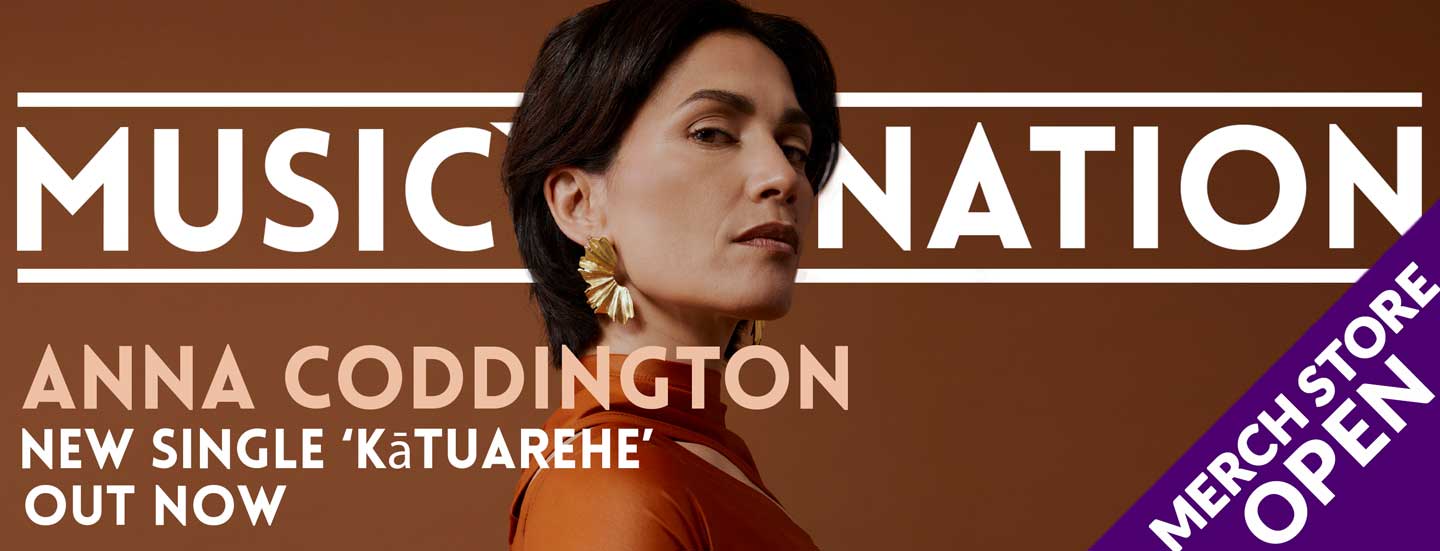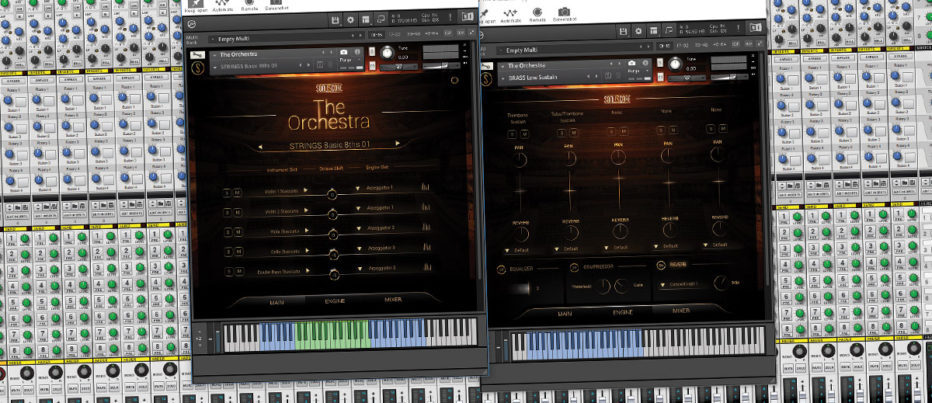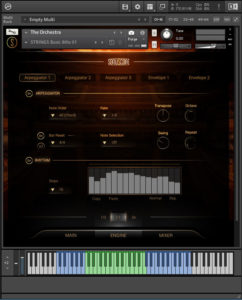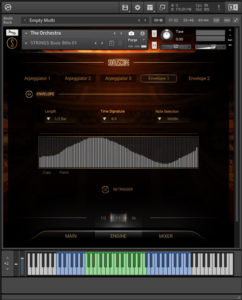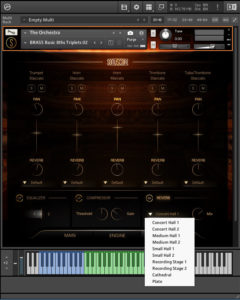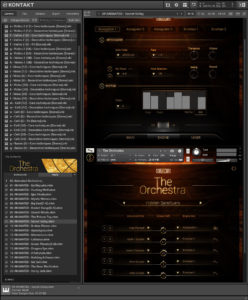SONUSCORE THE ORCHESTRA – ANIMATED PERFECTION
Greetings and welcome to our review of The Orchestra by Sonuscore. Being somewhat suspicious of the grandiose claims for this library, I am more than a little curious to see if the product can live up to the incredible demos making the rounds on the Internet recently.
With the vast number of orchestral sample libraries available these days, developers need to look outside the box for innovation. Sonuscore is bucking the current trend of providing ever-expanding mega-gigabyte libraries, instead offering an ‘orchestra in a box’ with a tiny data footprint and smart, one-finger workflow. It’s been tried before to limited success, so let us jump in now and see if The Orchestra can deliver where others have failed.
Overview
Sonuscore is the German developer responsible for the excellent Origin Series libraries we reviewed earlier this year. Featuring unusual pairings of dual instruments in a nifty interface, we were impressed with all three offerings in the current Origins lineup. The company has also collaborated with other high-end library collections, such as Action Strings and Trinity Drums, so their credentials are already established.
The Orchestra is essentially a supercharged version of the smaller Origins libraries with, of course, the focus on traditional orchestral instruments. The Orchestra requires at least the free version of Kontakt and employs the same layered multi-instrument concept, but this time up to five individual slots are available, each having access to rhythm and dynamics envelopes, expanded effects and a fully featured mixing desk.
Unlike its Origins Series brethren where much of the creative results were down to guesswork and happy accidents, The Orchestra features a very predictable and surprisingly intuitive step sequencer and dynamics envelope. Packed with a massive selection of instruments to choose from, the entire library only weighs in at a very surprising 6.5GB fully installed.
Though you can play each of the instruments as individual entities, the star feature of the library is its built-in step sequencer arpeggiators, mostly doing away with the tiresome chore of creating realistic-sounding ostinatos. The idea is that you layer each of the five individual instruments, applying separate mixes, effects and either one of the two animation engines. You can create almost unlimited variations from simple tutti ostinatos to extended passages with multiple complex orchestrations running in sync with each other.
The software wins on instant gratification right out of the box, providing hundreds of excellent animated sequences and multi-patch themes to showcase the possibilities.
The UI is a little old-fashioned with an antique gold font on a dark wood background, but it is well-designed and relatively easy to navigate
The Orchestra has been available now for over a year, and I have been playing with the latest v1.1 update which fixes a few bugs and adds a few more instruments to the collection.
What is in the box?
An impressive 80-piece orchestra is split into more manageable groups. You can load each as layers in the core patch or as individual playable instruments on their own. Everything gets a legato patch where applicable, and overall the library features an excellent selection of instruments and articulations to call on.
The stringed instruments are split up into ensemble groups: Violin 1 and 2, violas, cello and basses. The brass has four horns, three trumpets, three trombones, a tuba and bass trombone. Woodwinds include a flute, oboe, clarinet, bassoon and contrabassoon. Finally a selection of men’s and women’s choir, a harp, timpani, glockenspiel, tubular bells, cymbals, gran casa, snare, tam-tam, Piatti, taikos and a drum ensemble.
The included manual is basic and only shows the fundamental operations of the library. Fortunately, there are some excellent video tutorials online which probably suit most users who may prefer this to reading the manual.
The library has two main categories; “Instruments” containing the core “Orchestra” patch, and individual string, brass, woodwind, percussion and choir sections available, each containing isolated articulation patches if you prefer to separate out the instruments.
The percussion and choir sections differ slightly, in that they contain atonal instruments and vocal effects, respectively.
The second “Multi” category contains pre-made themes separated by three banks; Colours, Rhythms and Animations. Each can include many layered instrument instances with custom mix and rhythms.
Orchestral Colours is a mood category containing traditional and unusual combinations of instruments playing sustains, staccato or other typical styles. There is an excellent selection of epic-sounding styles to choose from and a good starting place for most compositions.
Rhythms feature 30 combinations of the core orchestra patch performing basic rhythmic patterns. Only 8th and 16th note intervals have been included with the library, but they are separated by common 4/4 and other odd-time signatures. Again, a great place to start if you want a full-sounding orchestra with more movement.
The final Animated category contains 20 themed orchestral presets, primarily to showcase the capabilities of the library, but also for you to build on or take inspiration from for your arrangements. Presets like Mystic Waters, Earthquake and A Fairytale provide expected results, whereas more intriguing offerings like Apocalypse, Rocket Range and Green Planets require exploration to reveal their secrets.
The takeaway lesson here is that patch layering is a good thing. While the library has good-sounding individual presets, it comes to life once multiple instances are combined and thoughtfully arranged.
The Sound
For a product that weighs in at less than 7GB downloaded and installed (and yes, it was the first thing I checked), I cannot believe how good this sounds. And it’s not hiding behind a load of effects and scripting trickery, that actual recording samples mostly sound extremely good.
There isn’t the full range of dynamic velocity layers you would expect in a heftier library, so on the whole everything sounds rather one-dimensional. But since The Orchestra sounds best vamping out ostinatos, this isn’t as much of a problem as you may expect.
While The Orchestra is really about the core patch and its rhythm and envelope engines, the library also comes with each of the core instruments separated out as playable solo patches. There isn’t a lot of depth in regards to round robins or velocity layers, making them all sound relatively flat. In some cases, this isn’t a huge problem, like with the excellent percussion category which is varied and epic sounding.
The surprisingly good choir category is usually the first to suffer in multi-instrument libraries like this. It’s not overly flexible; there is no word builder or anything like that. But certainly good enough to incorporate with your orchestral arrangements, and indeed other projects outside the library.
The brass and woodwinds, unfortunately, suffer the most and don’t stand up to scrutiny as solo instruments. Nothing wrong with the basic recording quality, it’s the lack of dynamics that is problematic. Again, as with the choir, excellent with the full tutti core patch, but not enough realism as solo instruments to convince me.
Getting back to the core patch, to a certain degree, much of the big sound comes from the room recording and built-in reverb effect, but the most useful feature is the animator controls which bring life and movement to the recordings. The samples also have a fair amount of baked-in room reverb, so it’s not the place to find dry and intimate sounds.
The digital reverb included sounds excellent, though somewhat heavy-handed for my taste. I found a much lighter, high-quality 3rd party convolution reverb that worked better for me taming back some of the massive roominess of the library. Eventide’s impressive Black Hole sounds excellent, as does East West’s latest Spaces 2, both providing amazing results and more flexibility over the default Kontakt effect.
Generally, the library responds very well to your touch, especially the wonderful staccato patches. There is immense satisfaction when hammering down 10-finger chords
Sound designers and film composers will love the gritty nature of the library. Arpeggios are super-tight, and everything responds well to FX treatment. Creating a DAW template with a few dozen themes on call provides instant total control over this orchestra, perfect for freestyling cue ideas.
Due to its rather epic nature, I found overlaying heavy rock drums, guitar and bass tended to swallow up much of the mid-low range space The Orchestra loves to dominate, resulting in rather washy results unless dramatic EQ is applied. For very bass-heavy urban or EDM music, The Orchestra feels right at home. The staccato main grooves work well will only slight EQ low-end roll-off.
The library, in general, has a very aggressive and bitey sound. Not so much raw, but as if the players were asked to really dig in when playing. Perhaps the string players used a little more dark rosin on their bows, the brass aimed more directionally at the microphones and the wind players forced the notes a little more. It all sounds more intense, more red-blooded and militant.
This all makes for loads of fun out of the box, but somewhat frustrating to reign in when you don’t need 80 players romping around ad infinitum throughout your arrangments.
Orchestral Manoeuvres
Ordinarily, there are a few ways you can try to avoid the tedious work of arranging orchestral ostinatos, mostly using pre-recorded sample phrases in some kind of creative way to appear intentional. Of course, pre-recorded phrases mean no matter how fantastic the scripted software is you are still fundamentally limited by the static recordings.
Though you could still consider The Orchestra a “Phrase” library, the phrasing comes from the clever step-sequencer and envelope curve engine, not pre-recordings.
Sonuscore’s simplistically genius approach provides a relatively small wave sample designed to work better as part of a sequence, ideally a multi-layered sequence. The step-sequencer triggers the wave samples in a specific order, providing similar phrase performances but with far greater flexibility for arranging.
The trade-off is as singular samples played outside the sequence as solo instruments don’t stand up as well, mostly in the release tails.
The star feature is the core engine which allows up to five instruments to be played at once, each with a separate combination of mix, effect and rhythm or envelope curve generators. Though five slots might not sound like enough, thanks to the minimal system resource requirements (around 200meg per instance), you can comfortably load five, six or more instances as you need.
Each of the five instrument slots has an engine assign drop-down; staccato notes can choose from one of three arpeggiators, and sustained notes have two curve envelopes available.
The arpeggiator engine has access to many preset rhythms and time signature patterns, or of course, create your own. This works only for short notes, so longs can choose an envelope curve which automates the crescendo of the chord over time, resulting in dynamic swells.
As an example, you perhaps might have violin one and two playing a tight staccato rhythm with arpeggiator one, the basses hitting pizzicato 8th notes using arpeggiator two, and the viola and cello playing sustained swells using envelope one.
Using this method, it is relatively painless to set up any number of passages running in sequence from your DAW. The software is smart enough to understand chord patterns too, so once the rhythm and envelope curve patterns are set, playing the actual notes is simple.
Unfortunately, there is no MIDI export option for further editing or even layering of other sample libraries.
To a certain extent, the system works better the more you layer on it. This is not to mask the sample recording quality, but more to aid the illusion of dynamics. Though the step-sequencer is clever, it is only 32 steps, so some degree of “computerness” is apparent when soloed, especially once a phrase loops a few times. Each subsequent instrument added helps to blur the performance, as long as you don’t hold on to a phrase for more than a dozen repeats or so.
In Use
The excellent humanisation feature is well-hidden under the global controls (front page, tiny gear icon on the top right of the GUI, by the way). This adds both rhythmic and dynamic inconsistencies to the performance in turn for a more human feel. Unfortunately, this does throw the timing out which is problematic when using two instances in sync.
Though this is one of the better implementations I’ve heard of “humanising”, you can’t define what you want to be affected. Sometimes just the dynamics would be great, other times perhaps both.
As mentioned, the feel is very immediate and agile. Even the longs have a rather fast attack if the dynamics modulation wheel isn’t utilised. For urgent, bombastic playstyle The Orchestra is perfectly set up. Due to no velocity scaling or curves, softer, more extended crescendos will require either a very keen manipulation of the mod wheel or clever MIDI scaling with a plugin.
Performance
As expected from such a minuscule data footprint, performance is excellent. Mostly everything loads almost instantaneously within only the larger core patch taking four or five seconds to load all of the sample memory fully.
I found loading layered instances barely affected system performance at all. Even upwards of ten instances didn’t hiccup our ageing PC system (i5 3200 with 16GB RAM).
The Orchestra tested flawlessly on all DAW platforms we use (Reaper, Studio One, Cubase), but some random clicking occurred while using Propellerhead Reason with a larger 12-track arrangement that required a reboot. Reason Studio is still in the teething stage of VST support, so this will be most likely a DAW/Kontakt issue.
I mentioned earlier about using 3rd party reverbs, disabling the built-in reverb for each instance and using a single, global insert effect sounds more coherent and dramatically reduces system requirements on larger multi-instance setups.
Conclusion
The Orchestra is a perfect example of what can be achieved when the focus is shifted from girth to agility. And though the library lacks somewhat in finesse, it makes for substantial gains with simplicity and ease of use.
The core ensemble patch with its vast selection of presets and themes to start you going is fantastic. Building on the provided examples with your creations is intuitive and quite fun.
Composing veterans may poo-poo this library as some kind of “cheating”, or perhaps composition easy mode. But I urge you to look beyond the one-finger multi and consider the benefits of quickly getting ideas into your DAW without the usual constraints of technology hindering your creativity.
Though The Orchestra won’t hold up against some of its high-end competition as a solo instrument, it has an essential ace up its sleeve in the form of automation. Nothing else on the market will allow you to create a selection of templates you can call on to nearly instantaneously get ideas out of your head and safely onto your DAW.
I don’t like to qualify statements by adding “for the price” or ” considering its small data-size”, because a product should stand up against others in its market sector, especially a flagship title at this price. It is clear some seriously clever thinking has gone into this platform, and it shows in the performance and flexibility of the arpeggiator and envelope engines.
Overall, a very impressive package. The Orchestra is intuitive to use, with excellent performance and a comprehensive selection of instruments on call.
More than just a one-trick pony, savvy users will immediately realise the potential to automate and streamline their composition processes. Though it certainly sounds amazing, the real success with The Orchestra is it removes the tech and allows you to quickly get ideas into your DAW, which at the end of the day, for me, is worth the retail price alone.
For full details and purchasing The Orchestra check out Sonuscores’ website

Like the review? Shout us a cup of coffee!
